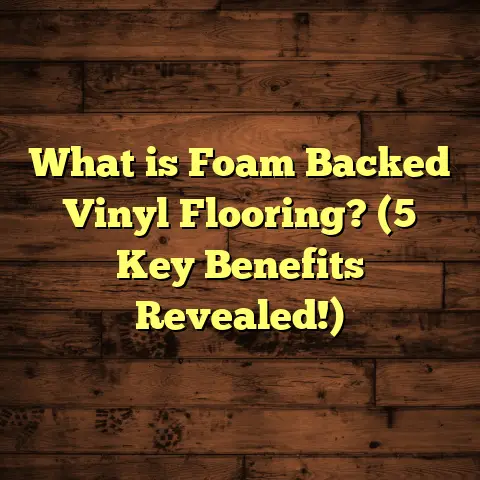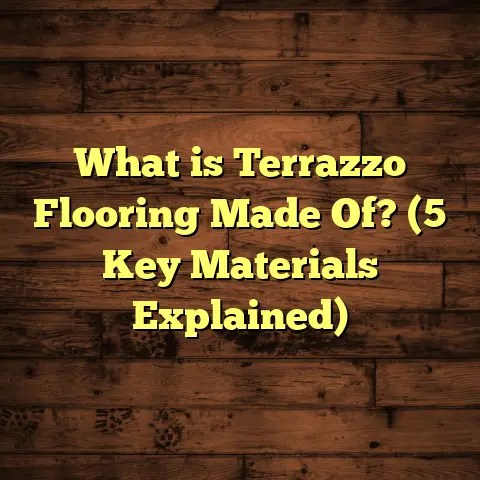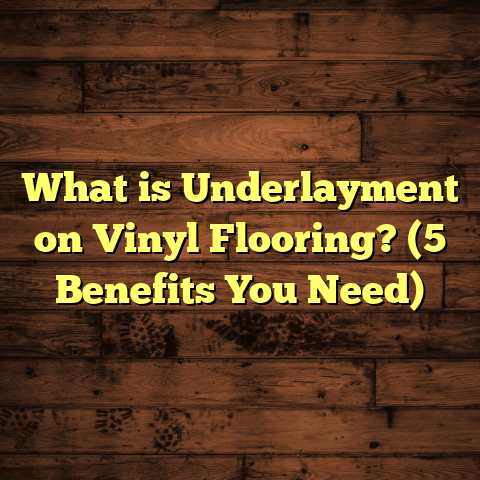What is a Cushion Floor UK? (5 Benefits You Need to Know)
Imagine waking up on a damp, chilly morning in your British home. As you shuffle from your bedroom to the kitchen, your feet hit the cold hard floor, sending a shiver through you. You reach for a warm slipper or rug, wishing there was something softer underfoot—something that feels inviting yet practical. This is the kind of problem I’ve encountered countless times as a flooring contractor working across the UK. And more often than not, my go-to recommendation has been cushion flooring.
If you haven’t heard much about cushion flooring or are unsure what it really is, don’t worry — I’ll walk you through everything you need to know. From its composition and installation to its benefits and real-world performance, I’ll share stories and data from my years in the business to help you make an informed choice about whether cushion floor UK could be right for your home.
What is Cushion Floor UK?
So, what exactly am I talking about when I say “cushion floor”? Cushion flooring is a type of resilient vinyl flooring that features a soft, cushioned backing layer beneath a vinyl wear surface. This combination creates a floor that’s comfortable to walk and stand on but also tough enough to handle everyday use.
In the UK, cushion floors have been popular particularly in kitchens, bathrooms, utility rooms, and hallways because they blend practicality with comfort. Unlike laminate or hardwood floors, which can feel cold and unforgiving, or carpets that can stain and trap dirt, cushion flooring offers a happy medium — soft underfoot but easy to clean.
Composition of Cushion Flooring
Let me break down the layers for you:
- Wear Layer: This is the top layer made of durable vinyl designed to withstand foot traffic, resist stains, and prevent scratches. The thickness of this layer varies depending on quality.
- Design Layer: This middle layer carries the printed design or pattern that mimics wood grain, stone, tile, or other textures. Modern printing technology creates realistic looks that can trick even the trained eye.
- Backing Layer: The bottom cushioning layer is usually made from foam or felt. This soft base gives the floor its signature “give” when you step on it. It also adds insulation and helps reduce noise.
This layered construction is what makes cushion flooring stand out compared to other vinyl or laminate options.
How Cushion Flooring Differs From Other Floors
You might wonder how cushion flooring compares to other types like vinyl sheets, luxury vinyl tiles (LVT), laminate, or hardwood.
- Compared to Vinyl Sheet Flooring: Cushion floor has a padded backing that makes it softer underfoot; standard vinyl sheets are thinner and less forgiving.
- Compared to Luxury Vinyl Tiles: LVT focuses on high-end visuals and durability but usually lacks the cushioning aspect.
- Compared to Laminate: Laminate floors are hard surfaces made from compressed wood fibers topped with a photographic layer. They feel solid but lack softness.
- Compared to Hardwood: Real wood floors offer classic beauty but are expensive, prone to scratches, and cold underfoot unless paired with rugs.
Cushion floors offer a unique balance of softness, durability, waterproofing, and affordability — making them especially suitable for busy family homes or spaces where standing comfort matters.
Why Should You Consider Cushion Flooring? My Top 5 Benefits
Let me take you through five benefits I’ve seen firsthand that make cushion flooring a standout choice for many homeowners across the UK.
1. Comfort That Makes a Difference in Daily Life
It might sound simple, but comfort is a huge factor for many people when choosing flooring. Traditional hard floors can be unforgiving on feet, knees, and backs — especially if you spend long hours standing in one place like cooking or cleaning.
I remember working with a woman named Sarah who loved hosting family dinners. After switching from tiled kitchen floors to cushion flooring, she told me how much easier it was on her legs during those marathon cooking sessions. She said it felt like walking on a soft carpet but without the messiness.
Scientific studies back this up too: research published by The Journal of Applied Ergonomics shows that floors with cushioned backing reduce muscle fatigue by around 30% compared to hard surfaces. That’s no small deal if you’re on your feet all day.
Tip: If you experience joint pain or have elderly family members at home, cushion flooring can be a game-changer in comfort.
2. Easy Maintenance Saves You Time and Effort
I’ve met plenty of busy families who dread cleaning floors because spills and dirt seem endless. One reason cushion flooring appeals is how easy it is to maintain with just regular sweeping and mopping.
Unlike carpets that need deep cleaning or hardwood that can get damaged by water, cushion floors resist stains and water damage thanks to their vinyl wear layer.
For example, a client with two young toddlers told me she loves how quick it is to wipe up juice spills without worrying about stains setting in. She also appreciates not needing special cleaners — just warm water and a gentle detergent do the trick.
From my experience:
- Regular sweeping prevents dust build-up.
- Occasional damp mopping keeps surfaces fresh.
- Avoid abrasive cleaners or waxes that can damage the wear layer.
3. Waterproof Nature Protects Against Moisture Damage
One of the biggest concerns for homeowners in damp British climates is moisture damage. Hardwood floors can warp or swell when exposed to water. Carpet can hold moisture and cause mold issues.
Cushion floors offer an excellent solution because their vinyl surface layer is completely waterproof. Spills don’t soak through; instead, they remain on the surface ready to be wiped away.
I installed cushion flooring in a coastal home where humidity levels fluctuated widely. Despite occasional water spills from wet shoes or pets, the floor remained intact with no signs of warping or mold growth over several years.
This makes cushion flooring ideal for bathrooms, kitchens, laundry rooms, and even entryways where wet weather boots track in moisture.
4. Affordable Flooring That Doesn’t Feel Cheap
When budgeting for renovations or new builds, cost matters — but so does style. Cushion flooring strikes an impressive balance here.
It’s typically priced between £15 and £35 per square meter, depending on brand and quality level. Compared to hardwood floors which can cost £50+ per square meter plus installation, cushion floors provide a budget-friendly alternative without sacrificing aesthetics or durability.
The variety of designs available today means you don’t have to settle for boring patterns either. Whether it’s oak woodgrain for a traditional look or bold geometric prints for modern flair, there’s something for everyone.
I once helped a young couple decorate their first flat with limited funds but big style dreams. Cushion flooring allowed them to achieve their desired look without emptying their savings.
5. Quick Installation Minimizes Disruption
If you’re like most people, you want renovations done fast so you can enjoy your home without weeks of mess or inconvenience.
Cushion flooring scores well here too because it’s relatively quick and straightforward to install compared to tiles or hardwood.
Typically sold in sheets or tiles with adhesive backing, it can be laid over existing smooth subfloors without tearing up existing surfaces — saving time and money on prep work.
At one job I handled in London, we installed cushion flooring across an entire kitchen and hallway in just two days. The homeowners were thrilled they could host their dinner party as planned without delay.
Real Stories & Insights From The Field
Let me share some stories that highlight what I’ve learned about cushion floors in real-life settings:
Story 1: The Family Kitchen Rescue
The Smith family had an old vinyl kitchen floor that was cracking and worn out after 15 years. Their children were constantly dropping food and drinks during meals — leading to lots of spills and stains.
They wanted something soft for the kids but practical enough to handle messes without needing constant replacement.
We installed a high-quality cushion floor with a thick wear layer and wood-look design. Within weeks:
- The children’s playtime was safer thanks to the cushioned surface.
- Cleaning up after meals became quicker.
- The kitchen felt warmer during winter mornings thanks to thermal insulation properties.
Mrs Smith later told me it was one of the best investments they’d made for family comfort.
Story 2: Elderly Couple’s Comfort Upgrade
Mr and Mrs Johnson found standing on their cold tiled hall floor painful because of arthritis. They wanted a softer alternative that wouldn’t be slippery for safety reasons.
I recommended cushioned vinyl with anti-slip coatings. After installation:
- Mr Johnson mentioned reduced knee pain when moving around.
- Mrs Johnson appreciated how quiet footsteps became — less echoing in their hallway.
- Both felt safer knowing the floor was slip-resistant despite being smooth-looking.
Their story illustrates how cushioned floors improve quality of life beyond just looks.
What Does Data Say About Cushion Flooring?
Here’s some factual information based on studies and industry reports that support why cushion floors are worth considering:
| Factor | Cushion Flooring | Hardwood Flooring | Laminate Flooring |
|---|---|---|---|
| Average Cost (per sqm) | £15 – £35 | £50 – £100 | £20 – £40 |
| Lifespan (years) | 10 – 20 | 25+ | 10 – 15 |
| Water Resistance | High | Low | Moderate |
| Comfort (foot fatigue reduction) | Up to 30% compared to hard floors | Minimal | Minimal |
| Maintenance | Easy (sweeping + mopping) | Moderate (polishing needed) | Moderate (scratches possible) |
These numbers show cushion floors are a practical choice for many homeowners balancing cost with comfort and durability.
Installation Tips From My Experience
Getting cushion flooring right means paying attention to details before laying down that first sheet:
Assess Your Subfloor
Make sure your subfloor is clean, flat, dry, and free from cracks. An uneven subfloor will lead to bubbles or creases in your cushion floor later on.
I often use self-leveling compound if needed before installation.
Moisture Testing
Check moisture levels especially if installing over concrete slabs or ground floors. Excess moisture can cause adhesive failure despite waterproof top layers.
A simple moisture meter test helps avoid surprises down the line.
Acclimatisation
Let your cushion flooring material acclimatise at room temperature for at least 24 hours before installation. This prevents expansion or contraction issues after laying it down.
Use Recommended Adhesives
Follow manufacturer guidelines on adhesives — some products require specific glue types for best results.
Caring For Your Cushion Floor: Do’s & Don’ts
To keep your floor looking great for years:
Do:
- Sweep daily or as needed
- Mop with mild detergent weekly
- Use felt pads under furniture legs
- Wipe spills immediately
- Use mats at entry points to catch dirt
Don’t:
- Use abrasive cleaners or steel wool
- Drag heavy furniture without protection
- Expose floors to standing water for long
- Use wax or polish products not designed for vinyl
Following these simple steps will protect your investment nicely.
Frequently Asked Questions About Cushion Flooring UK
Q: Can cushion flooring go over underfloor heating?
A: Yes — but check product specifications carefully as some foam backings might insulate heat too much. Many modern cushion floors are designed for compatibility though.
Q: Is cushion flooring suitable for high traffic areas?
A: High-quality options with thicker wear layers handle moderate traffic well but may not be ideal for commercial settings with extreme wear.
Q: How long does installation take?
A: For an average kitchen-sized space (15-20 sqm), expect 1-3 days including prep work.
Q: Can I DIY install cushion flooring?
A: Experienced DIYers can install smaller areas; however professional installation ensures best results especially for larger spaces.
Final Thoughts Based On Years Of Experience
I’ve worked on hundreds of projects across the UK where clients wanted warm, practical floors that don’t demand constant upkeep but still feel nice underfoot. Cushion flooring consistently ticks those boxes better than many alternatives in its price range.
If you want something soft yet durable, waterproof yet stylish — and easy to install plus maintain — it’s definitely worth checking out cushion floor options near you.
Next time you’re thinking about new floors, ask yourself: How important is comfort? Would easy care make life better? Could affordability shape my choices?
If those questions resonate with you like they do with many of my clients, cushion flooring might just be your perfect fit.
That’s quite a lot of ground covered! If you want specific product recommendations or help estimating costs based on your home size and location in the UK, just ask — I’m here to help make your flooring project smooth and successful.





